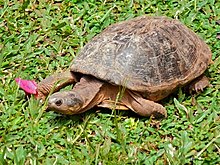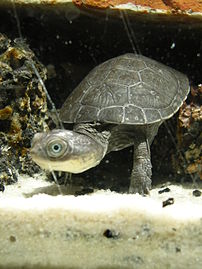
Pelomedusidae is a family of freshwater turtles endemic to sub-Saharan Africa, including Madagascar, São Tomé, and the Seychelles. They range in size from 12 to 45 cm in carapace length, and are generally roundish in shape. They are unable to fully withdraw their heads into their shells, instead drawing them to the side and folding them beneath the upper edge of their shells, hence are called African side-necked turtles.

The yellow-spotted Amazon river turtle, also known commonly as the yellow-headed sideneck turtle and the yellow-spotted river turtle, and locally as the taricaya, is one of the largest South American river turtles.

The eastern long-necked turtle is an east Australian species of snake-necked turtle that inhabits a wide variety of water bodies and is an opportunistic feeder. It is a side-necked turtle (Pleurodira), meaning that it bends its head sideways into its shell rather than pulling it directly back.

The red-footed tortoise is a species of tortoise from northern South America. These medium-sized tortoises generally average 30 cm (12 in) as adults, but can reach over 40 cm (16 in). They have dark-colored, “loaf”-shaped carapaces with a lighter patch in the middle of each scute, and a somewhat lighter-colored plastron (underbelly). They also have dark limbs dotted with brightly-colored scales, from which they get their name, that range from pale yellow to vivid or dark red. Visible differences are noted between red-footed tortoises from varying eco-regions. They are closely related to the more easterly-distributed yellow-footed tortoise of the Amazon Basin.

The Indian black turtle or Indian pond terrapin is a species of medium-sized freshwater turtle found in South Asia.

The northern river terrapin is a species of riverine turtle native to Southeast Asia. It has been classified as Critically Endangered on the IUCN Red List and considered extinct in much of its former range; as of 2018, the population in the wild was estimated at 100 mature individuals.

The black pond turtle, also known commonly as the spotted pond turtle and the Indian spotted turtle, is a species of freshwater turtle in the family Geoemydidae. The species, which is endemic to South Asia, belongs to the monotypic genus Geoclemys.

The Indian roofed turtle is a species of turtle in the family Geoemydidae. It can be distinguished by the distinct "roof" at the topmost part of the shell. It is found in the major rivers of South Asia. It is a common pet in the Indian Subcontinent.
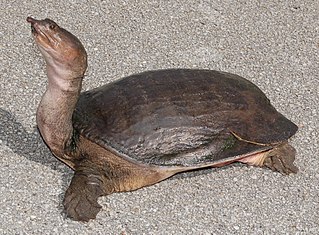
The Florida softshell turtle is a species of turtle in the family Trionychidae. The species is native to the Southeastern United States.
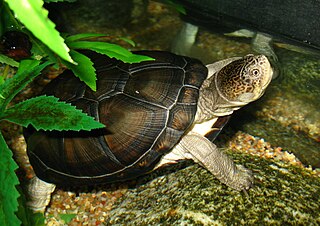
Pelusios is a genus of African side-necked turtles. With 17 described species, it is one of the most diverse genera of the turtle order (Testudines).
The Caspian turtle, also known as the striped-neck terrapin, is a species of turtle in the family Geoemydidae (=Bataguridae). It is found in west Asia, in Iran and central Turkey, northward to the Republic of Georgia and eastward to southwestern Turkmenistan, and in Iraq, Saudi Arabia, and Bahrain.

The big-headed pantanal swamp turtle or pantanal swamp turtle is a species of turtle in the family Chelidae found in Brazil, Bolivia, Argentina, and Paraguay.
The variable mud turtle, also known as Rhodesian mud turtle, Mashona hinged terrapin or variable hinged terrapin, is a species of turtle in the family Pelomedusidae. It is widely distributed in Central, East, and Southern Africa. The species was officially described by John Hewitt in 1927 and had to be broken into subspecies due to color variations on the heads of the turtles acrost the regions.

The East African black mud turtle, also known as the Pan terrapin, is a species of turtle in the family Pelomedusidae, native to eastern and southeastern Africa.

Siebenrockiella crassicollis is a freshwater turtle endemic to Southeast Asia. It is one of two species classified under the genus Siebenrockiella in the family Geoemydidae.

The saw-shelled turtle is a species of turtle in the Chelidae family endemic to Australia, ranging along rivers and streams and connected swamps and lagoons from coastal Cape York Peninsula to northern New South Wales, with populations also noted as far south as Newcastle -. They are thought to have been introduced to Lake Eacham in the Atherton Tablelands. Other common English names are: serrated snapping turtle or common sawshell turtle.

The Balkan terrapin or western Caspian terrapin is a species of terrapin in the family Geoemydidae. It is found in the eastern Mediterranean region. While technically omnivorous, the terrapins are known to prefer meat. They can grow to 25 cm in carapace length, although hatchlings are usually only 3 to 4 cm in length.
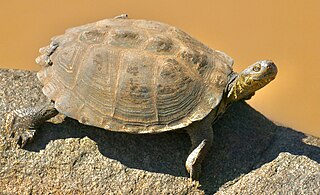
The serrated hinged terrapin is a species of turtle in the family Pelomedusidae. The species is native to East Africa and Southern Africa. There are two recognised subspecies.

The western black-bridged leaf turtle is a species of Asian leaf turtle found in southern Indochina.

Adanson's mud turtle is a species of turtle in the family Pelomedusidae. The species is endemic to north-central Africa.
